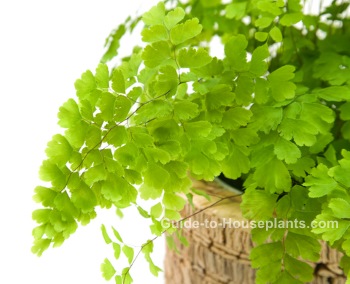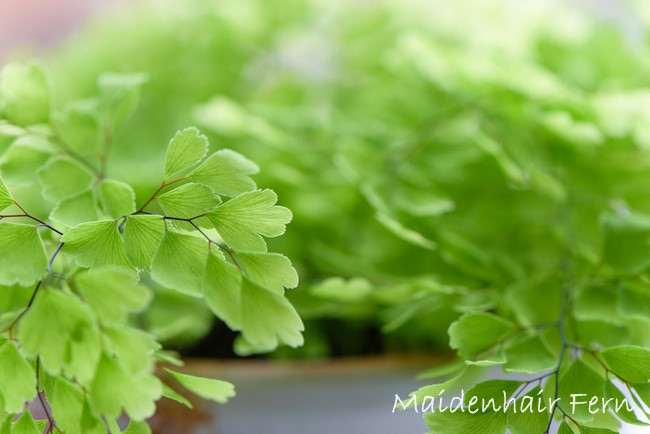How to Grow Maidenhair Fern Indoors
Delicate and airy Maidenhair Fern brings a surge of verdant vitality to a room where you want a tropical vibe.
Although delightful to look at, those nodding leaflets demand high humidity, making this fern difficult to please indoors. But don't write off this houseplant just yet. Here you'll discover just what it takes to keep this fussy fern healthy and thriving.

Get to Know Maidenhair Ferns
Delta Maidenhair Fern is a foliage plant with arching, black, wiry stems covered with green triangular leaflets, called pinnae.
One of the most commonly grown in a container, Adiantum raddianum is well-worth growing for its stunning foliage. It will live a long time, too, with good care.
This beautiful fern grows from rhizomes, that spread quickly just under the surface of the soil. You'll enjoy many plants over time by propagating Maidenhair Fern. It's easy to divide.
How big does it get? Adiantum raddianum will grow 6-15 inches (15-38 cm) tall, and can reach a width of 24 in (60 cm) or more.
Repot in spring when it has outgrown its pot, using a container that provides good drainage. This is a good time to divide the fern, if needed.
Maidenhair Fern has origins in the rainforests of Brazil and Venezuela, where it is bathed in humidity all year long. This tropical native is demanding of higher-than-average indoor humidity, which may take some effort on your part. (See "Humidity" tip below.) This beauty grows best in terrariums where humidity is kept at a high level. Drafts and dry air will cause leaflets to shrivel.
Pruning tip: Cut the stems off at the base if the leaflets dry up or fall off. Keep soil moist and raise the humidity around the fern to encourage new growth. Mist twice a day until new shoots appear.
Maidenhair Fern Problems, Solutions and Answers
Yellow leaf tips are often a sign of overwatering. Trim off yellow leaflets to keep the fern looking neat and reduce watering. Also, check the roots to see if they have rotted. Healthy fern roots have white to light brown tips. If the roots are mostly black, get rid of it -- it's too far gone.
Brown leaflets may be caused by low humidity, although old fronds naturally turn brown. Cut them off and boost the humidity around your fern.
Wilted fronds are likely a symptom of underwatering. Always water thoroughly to avoid any dry pockets in the soil.
Something bugging your fern? Not many pests bother Maidenhair Fern. However, scale and mealybugs are the most common. Check the fronds regularly for infestations. They are much easier to remedy if caught early.
Are Maidenhair Ferns poisonous? No, they're non-toxic to cats, dogs and people. Of course, you don't want your pets nibbling on your houseplants, but this is one you won't have to worry about.
Repot in spring. Don't pack the potting mixture; keep it loose to help drainage. You can encourage a small fern to grow bigger by moving it to a slightly bigger pot. Want to keep your houseplant small? Remove Maidenhair Fern from its container and prune off up to one-third of its roots before repotting it in the same pot.
 Sprays of light green leaflets on wiry stems make Maidenhair Fern an elegant houseplant. Photo credit ©Elena Vyaseleva
Sprays of light green leaflets on wiry stems make Maidenhair Fern an elegant houseplant. Photo credit ©Elena VyaselevaCaring for Maidenhair Fern Indoors
Light: Moderate to bright light. No direct sun.
Water: Keep soil evenly moist, but not soggy. Remember to use a pot with drainage holes so that water can drain freely.
Humidity: Requires moist air that rarely drops below 50% relative humidity. For a healthy houseplant, use a cool-mist room humidifier or plant in a terrarium. Brown leaf tips are a symptom of dry air.
Temperature: Average room (65-75°F/18-24°C) temps are ideal. This rainforest native doesn't like temperature swings. It's a good idea to keep Maidenhair Fern away from drafty entryways and air vents where it may catch blasts of cold or hot air.
Soil: Combine half potting mix with half peat moss. Don't use a potting mix that contains fertilizer (it can dissolve too fast and burn delicate fern roots).
Fertilizer: Feed once a month spring through summer with a balanced houseplant fertilizer diluted by half. Fertilize after watering to prevent burning roots.
Propagation: Division. This fern grows from rhizomes that spread horizontally just beneath the surface of the soil. Divide clump in spring, leaving rhizome attached to 1-2 fronds, and pot in its own container.


